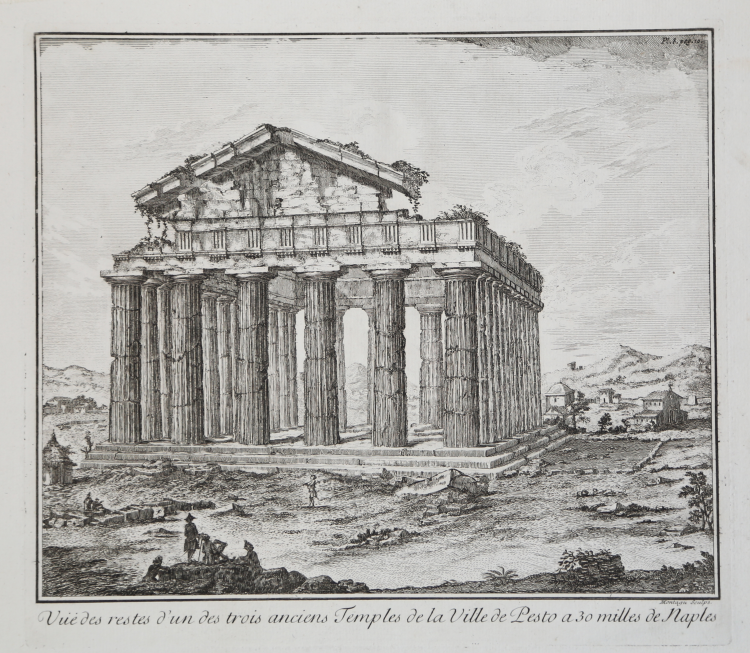



| Reference: | S4144 |
| Author | Jean BARBAULT |
| Year: | 1761 |
| Zone: | Paestum |
| Printed: | Rome |
| Measures: | 305 x 270 mm |


| Reference: | S4144 |
| Author | Jean BARBAULT |
| Year: | 1761 |
| Zone: | Paestum |
| Printed: | Rome |
| Measures: | 305 x 270 mm |
Taken from Les Plus Beaux Monuments de Rome ancienne, printed in Rome by Bouchard & Gravier - Komarek, 1761.
The work is a rich and elegant textual and iconographic collection of the artistic and architectural beauties of ancient and modern Rome.
The plates - often with wide margins - are mainly made by Barbault; other engravers on the plates were Montagu, Bouchard, Freicenet.
Barbault differentiated himself from his artistic rival Giambattista Piranesi, choosing to represent buildings and ancient monuments that Piranesi had portrayed from different angles and points of view, so that he could fill the iconographic gaps that could be found in the architect's works.
Copperplate, in very good conditions.
|
Rossetti 755; Berlin Katalog 1897; Cicognara 3593.
|
Jean BARBAULT (Viarmes, presso Chantilly, 1 Agosto 1718; Roma, 28 Maggio 1762).
|
French painter and engraver. A pupil in Paris of Jean Restout II, in 1745 he failed to win the Prix de Rome and at his own expense went to Rome early in 1747. The following year, by which time he was a member of the circle of Paolo Anesi, Philothée-François Duflos, Jean-Laurent Legeay and Giovanni Battista Piranesi, Barbault made engravings for the Varie vedute di Roma antica e moderna published in Rome. As a painter he was encouraged by Jean-François de Troy, director of the Académie de France, who commissioned from him 20 small pictures representing characters from the Turkish masquerade organized by the pensionnaires for the carnival of 1748, of which 11 survive (Beauvais, Mus. Dépt. Oise; Narbonne, Mus. A. & Hist.; Paris, Louvre; Venice, Col. Cini; and elsewhere). When, by special favour, he became a pensionnaire at the Académie (1749–53), he made a copy (Lille, Mus. B.-A., destr. 1916) for Louis XIV of Luca Penni’s fresco the Baptism of Constantine in the Vatican Stanze (it was then attributed to Raphael). While travelling in Rome, Abel-François Poisson de Vandières, Marquis de Marigny, commissioned a series of Italian Costumes, of which some of the originals or replicas remain (Castres, Mus. Goya; Dijon, Mus. B.-A.; Orléans, Mus. B.-A.; Paris, Louvre). In 1751 Barbault depicted the planned procession of the pensionnaires for the carnival in a frieze-like painting (380*3920 mm), the Masquerade of the Four Corners of the World (Besançon, Mus. B.-A. & Archéol.). Many of Barbault’s idealized Roman landscapes date from this period (examples Angers, Mus. B.-A.; Baltimore, MD, Walters A.G.; Madrid, Mus. Cerralbo; Notre Dame, IN, Snite Mus. A.; and elsewhere), but above all he wanted to be a painter in the grand manner, painting St François de Sales Placing Jeanne de Chantal under the Protection of St Vincent de Paul (Rome, SS Giovanni e Paolo) for the beatification of Ste Jeanne de Chantal in 1751. He also painted an Allegory of the Earth in c. 1752–3 for the wife of the Austrian ambassador in Naples, Paul Esterhazy, to accompany Gabriel-François Doyen’s Air, Charles-François de La Traverse’s Water and Pierre-Charles Le Mettay’s Fire.
|
|
Rossetti 755; Berlin Katalog 1897; Cicognara 3593.
|
Jean BARBAULT (Viarmes, presso Chantilly, 1 Agosto 1718; Roma, 28 Maggio 1762).
|
French painter and engraver. A pupil in Paris of Jean Restout II, in 1745 he failed to win the Prix de Rome and at his own expense went to Rome early in 1747. The following year, by which time he was a member of the circle of Paolo Anesi, Philothée-François Duflos, Jean-Laurent Legeay and Giovanni Battista Piranesi, Barbault made engravings for the Varie vedute di Roma antica e moderna published in Rome. As a painter he was encouraged by Jean-François de Troy, director of the Académie de France, who commissioned from him 20 small pictures representing characters from the Turkish masquerade organized by the pensionnaires for the carnival of 1748, of which 11 survive (Beauvais, Mus. Dépt. Oise; Narbonne, Mus. A. & Hist.; Paris, Louvre; Venice, Col. Cini; and elsewhere). When, by special favour, he became a pensionnaire at the Académie (1749–53), he made a copy (Lille, Mus. B.-A., destr. 1916) for Louis XIV of Luca Penni’s fresco the Baptism of Constantine in the Vatican Stanze (it was then attributed to Raphael). While travelling in Rome, Abel-François Poisson de Vandières, Marquis de Marigny, commissioned a series of Italian Costumes, of which some of the originals or replicas remain (Castres, Mus. Goya; Dijon, Mus. B.-A.; Orléans, Mus. B.-A.; Paris, Louvre). In 1751 Barbault depicted the planned procession of the pensionnaires for the carnival in a frieze-like painting (380*3920 mm), the Masquerade of the Four Corners of the World (Besançon, Mus. B.-A. & Archéol.). Many of Barbault’s idealized Roman landscapes date from this period (examples Angers, Mus. B.-A.; Baltimore, MD, Walters A.G.; Madrid, Mus. Cerralbo; Notre Dame, IN, Snite Mus. A.; and elsewhere), but above all he wanted to be a painter in the grand manner, painting St François de Sales Placing Jeanne de Chantal under the Protection of St Vincent de Paul (Rome, SS Giovanni e Paolo) for the beatification of Ste Jeanne de Chantal in 1751. He also painted an Allegory of the Earth in c. 1752–3 for the wife of the Austrian ambassador in Naples, Paul Esterhazy, to accompany Gabriel-François Doyen’s Air, Charles-François de La Traverse’s Water and Pierre-Charles Le Mettay’s Fire.
|